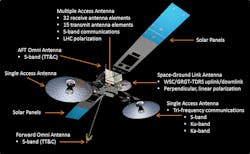TDRS Communications Satellite Uses Ground-Based Beamforming
For over 30 years, NASA’s Tracking and Data Relay Satellite (TDRS) fleet has provided communications support for a variety of missions and launch vehicles. Examples include the Hubble Space Telescope and the International Space Station. Of the 11 TDRS satellites that have launched, eight are currently still in operation. TDRS-L, the second of three replenishment satellites, recently arrived at Kennedy Space Center in anticipation of attachment to a United Launch Alliance Atlas V rocket.
The satellite payloads contain multiple antennas to provide near-continuous high-bandwidth telecommunications service. A phased-array antenna at S-band multiple access is designed to receive signals from up to five spacecraft simultaneously. It can transmit to one spacecraft at a time through 32 receive and 15 transmit elements. Two mechanically steerable, or gimbaled, antennas provide high-gain support at S-band, Ku-band, and Ka-band single access. Operation at Ku-band enables the support of two-way high-resolution video and customer science data. Ka-band operation allows data transmission at 800 Mbps as well as international compatibility. Forward-omnidirectional and AFT-omnidirectional antennas provide S-band telemetry, tracking, and command.
The TDRS Project was established in 1973 to provide continuous, around-the-clock communications services to critical low-Earth-orbiting missions while improving the amount of data that could be received. The building of all three next-generation satellites is contracted to Boeing Space Systems as a part of NASA's Space Communications and Navigation Program.
About the Author
Iliza Sokol
Associate Digital Editor
Iliza joined the Penton Media group in 2013 after graduating from the Fashion Institute of Technology with a BS in Advertising and Marketing Communications. Prior to joining the staff, she worked at NYLON Magazine and a ghostwriting firm based in New York.

